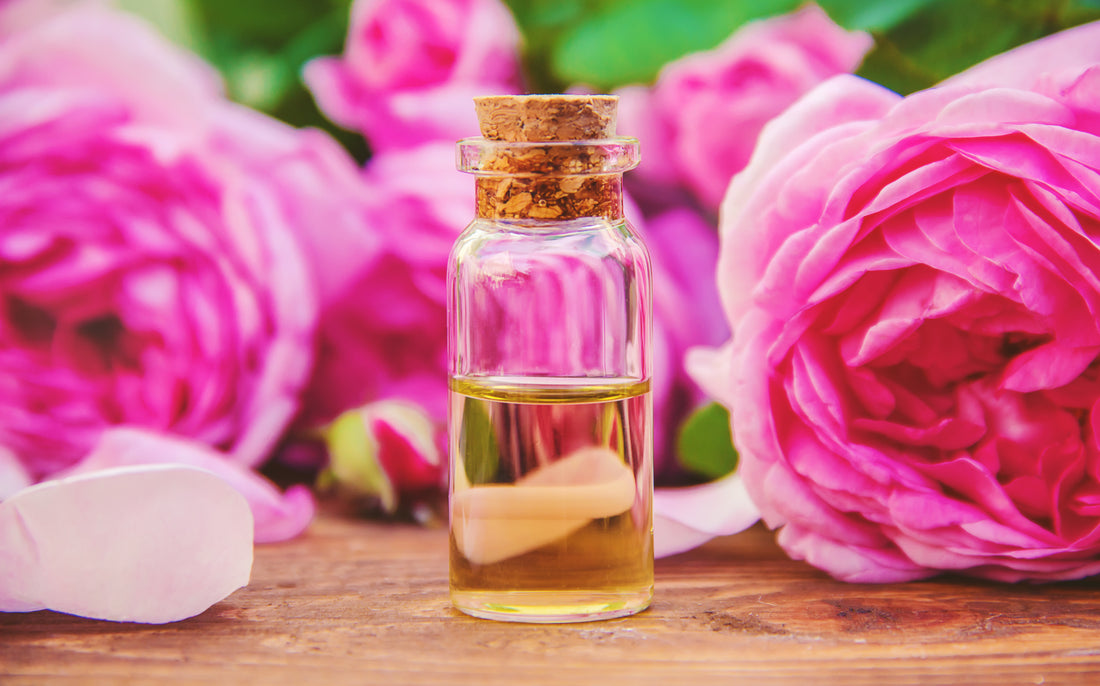
Rose Oil
Share
For centuries Rose oil has been thought to have beauty enhancing properties in regards the appearance of the skin. The pathophysiologic basis is likely multifactorial. Topical in vivo applications of rose oil from the petals of Rosa damascena (Miller) have been reported to improve skin barrier function and promote keratinocyte differentiation. Furthermore, antioxidant and antimicrobial activities of rose oil have been observed. The mechanism may lie in the enhanced expression of involucrin, which is a marker of keratinocyte differentiation. Rose oil extract also increased the level of filaggrin in cultured keratinocytes. Overall the beneficial effect of rose oil is in the context of improving barrier function by its positive effects on the integrity of the stratum corneum. There are generally two species of roses that are used in skin care: rosa damascena and rosa centifola. The former, often hailing from Bulgaria, has a deep, potent scent; the latter, known as the cabbage rose or the Moroccan rose, has a lighter, clean and sweet scent. Both are valued for their pure essential oils, derived from the rose flowers. It takes tens of thousands of rose blossoms, picked as they are unfolding in the early hours of dawn, to yield 1 ounce of rose essential oil. That makes rose oil one of the most expensive essential oils; it's so concentrated, however, that only a few drops are necessary to reap the benefits.
Roses are known for their intense hydrating properties, which make them perfect for mature and dry skin. Rose extract is “a cell rejuvenator that help minimize scars, stretch marks and wrinkles,” says beauty specialist and aromatherapist Janice Rosenthal, owner of Garden of Essences. “It heals broken veins and calms inflamed or sunburnt skin.”
Some of the earliest work to indicate the potential health and dermatologic benefits of R. damascene dates to the late 1970s. Rose essential oil acts as a superb emollient to moisturize skin, protecting the skin from moisture loss and preventing free radicals and toxins from entering the skin. The skin’s moisture barrier is a critical part of the immune system, and helps the skin maintain its proper level of nutrients.
If you strip your skin of moisture using harsh cleansers, your skin is likely to start over-producing oil to compensate. Roses can help balance the hydration of skin, which in turn can help prevent excess oil production. The high levels of antioxidants and fatty acids in rose essential oil and rose hip seed oil can also help maintain a proper balance of moisture in the skin, which is essential to effectively fight acne. The high vitamin C content can also help fade acne scars and prevent new hyper pigmentation from forming.
Investigators isolated a strain of cultured cells of the plant that displayed strong resistance to UV radiation (254 nm) and generated a greater amount of polyphenols (primarily flavonoids) during the latter stages of culture growth. They found that this UV resistance was associated with increased polyphenolic production (Murphy et al, 1979).
In 2003, investigators assessed various extracts of R. damascena for its capacity as an antisolar agent in absorbing UV. The presence of flavonoids as the primary constituents of the extracts was verified before investigators identified the UV absorption spectra, with all three extracts found to be effective in absorbing UV in the 200- to 400-nm range. Next, the team incorporated the extracts into oil-in-water creams at 5% and 8% concentrations. The hydroalcoholic extract provided the highest sun protection factor (SPF), but the cream containing 5% ether extract rendered the most satisfactory appearance and stability. The authors ascribed the UV absorption ability of the extracts to the flavonoid constituents and noted that other synthetic antisolar compounds might be added to R. damascena extracts to enhance overall product efficacy (Tabrizi et al, 2003).
In 2005, Schiber et al. extracted and characterized flavonol glycosides from R. damascena petals following industrial distillation for essential oil recovery. After analyzing 22 constituents, kaempferol and quercetin were the only flavonoids (specifically, flavonols) detected, with kaempferol compounds accounting for 80% of the compounds measured. In noting the high flavonol content (approximately 16 g/kg in dry weight), the researchers concluded that R. damascene represents a promising source of natural antioxidants (Z. Naturforsch. C., 2005)
In a late 2010 study using a reversed-phase high-performance liquid chromatographic (RP-HPLC) method to simultaneously measure the flavonols, flavones, and phenolic acids as important constituents in various fruits, vegetables, and medicinal plants, R. damascena was identified as one of the species, along with Solidago virgaurea, Ginkgo biloba, and Camellia sinensis (the source of green tea), as having the highest flavonoid content. As German scientists explained in a 2010 article, one of the most intriguing aspects of rose essential oil is that, “For substances applied in rose oil, a clear relationship between their lipophilic character, chemical structure, and skin permeation could be confirmed.” (Schmitt S et al, 2010).
Containing a complex array of vitamins, minerals, and antioxidants, rose essential oil has excellent emollient properties for moisturizing dry skin; it also offers antiseptic and astringent properties to treat acneic skin, as well as anti-inflammatory properties that help treat redness and inflammation. Rose oil can also help refine skin texture, controlling skin diseases such as psoriasis and atopic dermatitis. A study has even shown that rose essential oil can help heal wounds, as inhaling it inhibits water loss in the skin and lowers the concentration of cortisol (a stress hormone) in the body.
